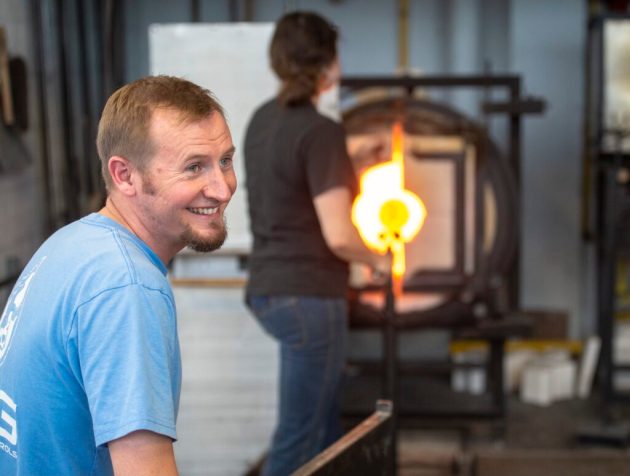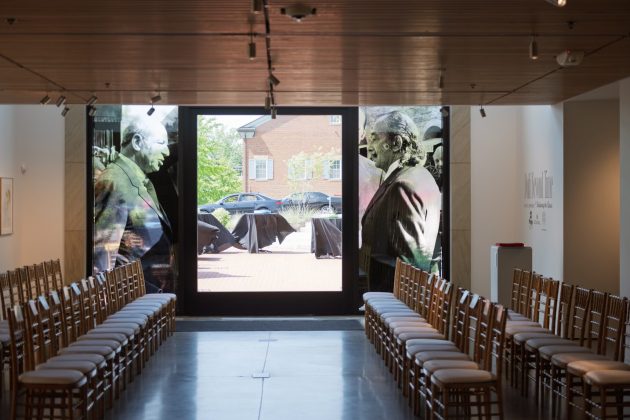
By Elizabeth Weinstein
When Jason Toth first toured the empty 1,800-square-foot space at 78th Street Studios in January, he understood why owner Dan Bush had hesitated to show it to him. The walls were red, shag carpet covered the floors, and it had the dated feel of its former life as a boudoir photography studio.
But to Toth, it was perfect.
Known for creating hyper-color photographic art using architecture and natural landscapes as raw material, he had been searching for a studio with character. “It’s like the universe is saying, ‘Here’s a gift,’” he told Bush.
Within two months, he had transformed it into an immersive, multi-sensory art oasis, opening to the public in March.
“I created this studio as a combination of all the things that helped me find myself,” he says. “I believe that it can resonate with other people. … There’s the artwork that I create on the walls, but truly, this whole space — this is my art.”
In this conversation, Toth shares the story of his creative process and the 2019 illness that upended his life — inspiring him to create art “as a means to reimagine reality, bringing color to life when it feels like it’s being sucked out.”
Your life changed in 2019, when you were diagnosed with Postural Orthostatic Tachycardia Syndrome (POTS). What’s it like to live with?
I got sick in August 2019. I was outside gardening, it was really hot, and when I stood up, my legs gave out. I blacked out for a second. When I got up, I was hit with intense vertigo. Every time I stood, the vertigo came back. After a couple of days, it still wasn’t going away. I saw a neurologist who recognized the symptoms and made the diagnosis.
He told me, “This is what you have. It’s a lifelong condition. It’s manageable, but it’s gonna suck. You’ll have to make a lot of lifestyle changes.” You have to relearn how your body functions, essentially.
On the drive home from the neurologist’s office, before the news had even fully settled in, my first reaction was: I have to figure out how to have a fulfilling life with this.
How did you define success before your diagnosis?
I feel like success means something different when you have more control over your body and your circumstances. You gauge your success based on what you say you’re going to do and then whether or not you do it when you say you will.
At the time, I had my own marketing business. It was small but I had two full-time employees. I had a vision for what I wanted the company to be and how big I wanted it to grow. I was very driven by that. I wanted to be a successful entrepreneur and a creative marketer.
That ended in 2019.


How did your definition of success change?
I lost my income source, and I was self-employed. I ended up having to shut down my business, and that just shattered me completely.
I was depressed, and I felt like I was losing myself. I was losing my identity, everything that I had anchored myself to. Most people can have a good idea of what’s going to happen tomorrow. I was in a position of, I have no idea what my life looks like. Everything has just changed. And that’s scary, especially when you don’t know what you’re going to do about it.
That’s where my personal transformation started — therapy, reading, listening to podcasts and audiobooks on the nervous system. I started meditating. It was very intense.
I had let go of my creative self for a long time. One of the reasons I had started my marketing company was I thought that was the only way that I could pursue a creative life and make a good living.
I started thinking about photography. I’ve been doing photography my entire life. I was always the documentarian of the family. Taking photos always lit me up. For the first couple of years post-diagnosis, I spent most days in bed. It was my camera that got me out of my bed.
Now, my only goal is to make life worth it.
Have you noticed more awareness of POTS since the COVID-19 pandemic?
I am always surprised when someone has heard of it, or knows somebody who has it. Most people haven’t. It’s a very isolating thing to have a chronic illness. It’s very lonely.
Most of the time I see the silver lining in having the health challenges that I do, because as a result I’m more authentically me, and I’m pursuing something that genuinely fulfills me.
Walk me through your creative process.
When I take photos, most of the time I try to drop the narrative and the labels of what I’m looking at. Instead, I look for the shapes, colors and patterns. I’m more influenced by abstract painters than photographers.
Everything I do is self-taught. My early work was all done in Lightroom, a photo editing software. The colors you see in my pieces come from the actual photograph, but what I learned is that “yellow” is not yellow. There are so many different shades of yellow. And tweaking one shade of yellow one way, and another shade of yellow that same way, can produce vastly different colors.
I started using masks in Lightroom, and within those masks I could manipulate the colors all over again. My pieces are built on masks upon masks upon masks upon masks.
I also identify with and project a lot of myself onto Cleveland. There are so many places that I want to photograph. I find I’m always discovering something in Cleveland that blows me away. I have a deep personal connection with this city.
You’ve said people often cry when they see your work. Why do you think that happens?
I continue to be overwhelmed by how my artwork connects with people. I’ve been a full-time artist for less than three years, and on six different occasions, I’ve seen my work make a grown adult cry. I think it has something to do with the familiar presented in a surreal way.
The color grabs people’s attention. Then they see something familiar — Terminal Tower, the Guardians, Severance Hall, the art museum, a willow tree at Edgewater Park, a steel mill — which activates their memories.
These places are iconic to Cleveland, and they’re ubiquitous to the point where they’re beautiful but mundane. With my art, it’s like people are seeing them for the first time again. They say, “I never noticed that level of detail in the Guardians,” or “I didn’t realize that the top of the Terminal Tower had all these columns.”
Tell me about your studio.
It’s not only where I spend most of my time and create my art — it’s where I display it, host gatherings, and built my immersive installation Surrender & Smile. Inspired by my health condition, it absolutely floors people.
In Surrender & Smile, produced by Audimute, my artwork, reactive lighting, high-fidelity sound, and color come together to facilitate awareness, relaxation, or gratitude. The entire space is treated with my artwork on acoustic panels made from recycled denim, so it’s also about the absence of sound. At its heart, it’s a place for mindfulness, and how someone experiences that depends on what they’re going through. It’s like a sound bath.
Early in my journey with POTS, I rediscovered my love of music through meditation. I turned my guest room into a listening sanctuary — a profound experience I wanted to share. Most people haven’t experienced music the way artists intended, in stillness and without distraction. That’s what inspired this space.
I want it to be more than an art studio — a place for creative conversations and small events. I’ve talked with musicians about doing my own version of NPR’s Tiny Desk Concerts, focusing on Cleveland artists. My neighbor has a recording studio with all the equipment.
In August, I hosted a conversation series with Teaching Cleveland on the city’s golden age of architecture and vision — surrounded by artwork that reimagines Cleveland in surreal ways. My hope is that this space inspires conversation and new ways of seeing things.













